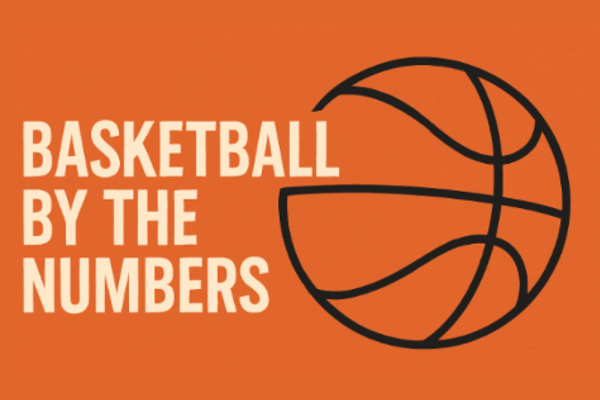Basketball is a game where numbers matter just as much as skill. From court dimensions to fouls, every rule and statistic contributes to how the game is played and how it’s won. Whether you’re just starting out or have been watching for years, understanding basketball by the numbers gives you a deeper appreciation of the sport.
From shot clocks to jersey numbers, there’s a lot more going on than what you see on the scoreboard. Let’s break it all down with answers to the most common questions about the structure and rules of basketball.

Table of Contents
- 1 What Is the Size of a Basketball Court?
- 2 What Size Is a Basketball?
- 2.1 What basketball jersey numbers are allowed?
- 2.2 How many fouls are allowed in basketball?
- 2.3 How Long Is a Basketball Game?
- 2.4 How Long Is the Shot Clock?
- 2.5 What is the size of the basketball hoop?
- 2.6 How many players are on a basketball team?
- 2.7 What are team fouls?
- 2.8 Frequently Asked Questions
- 2.9 Conclusion
- 2.10 What’s Next
- 2.11 Related Posts:
What Is the Size of a Basketball Court?
The dimensions of a basketball court aren’t one-size-fits-all. They change based on the league and level of play, which can affect game speed and spacing. Court size varies depending on the level of play:
- NBA and College: 94 feet by 50 feet.
- FIBA (International): 92 feet by 49 feet.
- High School: 84 feet by 50 feet.
- Youth Leagues: Around 74 feet by 42 feet.
These differences help tailor the game to player development and competition level. Understanding court dimensions can enhance your strategic awareness on the court.
What Size Is a Basketball?
Basketball sizes vary by age and gender, impacting grip, control, and shooting development. Understanding the right size helps players build proper technique.
- Men’s (Size 7): 75–76 cm in circumference.
- Women’s (Size 6): 72–74 cm in circumference.
- Youth (Size 5): 69–71 cm.
- K–2 (Size 3): 56–57 cm
Choosing the right ball size ensures better handling, especially for younger or smaller players.
What basketball jersey numbers are allowed?
Jersey number rules differ between pro and amateur basketball, mainly to help referees communicate clearly.
- Professional Leagues: Any number is allowed.
- Youth, High School, College: Only use digits 0–5 (e.g., 0, 00, 1–5, 10–15, up to 55).
Limiting digits to 0–5 allows referees to easily signal player numbers using one hand.
How many fouls are allowed in basketball?
Foul limits vary depending on the league and are designed to balance fair play with game flow.
- High School and College: 5 personal fouls.
- NBA/WNBA: 6 personal fouls.
- Youth Leagues: Sometimes allow up to 10 to emphasize learning.
Knowing foul limits helps players stay eligible to play longer and contribute to their team. Technical fouls are different from personal fouls and usually involve unsportsmanlike behavior or rule violations:
- Players may be ejected after 1–2 technical fouls depending on severity.
- Technicals often count as personal fouls unless stated otherwise.
- NBA Rule: 16 unsportsmanlike technical fouls in a season lead to a one-game suspension.
Managing your emotions and respecting the rules is crucial to avoid technical fouls. Staying composed on the court can make all the difference in close games.
How Long Is a Basketball Game?
Game length depends on the level of play, affecting pace and stamina.
- Youth: 6–8 minute quarters.
- High School: 4 x 8-minute quarters (32 minutes).
- College: 2 x 20-minute halves (40 minutes).
- WNBA: 4 x 10-minute quarters.
- NBA: 4 x 12-minute quarters.
Knowing the game’s duration helps players and coaches plan strategy and manage timeouts effectively.
How Long Is the Shot Clock?
The shot clock controls the pace of play and encourages offensive movement.
- Youth Leagues: Usually no shot clock.
- High School (in select states): 30–35 seconds.
- College: 30 seconds.
- NBA/WNBA: 24 seconds.
Shorter clocks increase pressure on offenses to make quick, efficient plays.
What is the size of the basketball hoop?
The size and height of a basketball hoop are standardized for official play, but youth leagues adjust the rim height to suit younger players. Here’s how it breaks down:
- Rim Diameter: 18 inches.
- Rim Height (Standard): 10 feet from the ground.
- Backboard Size: 72 inches wide by 42 inches tall.
- Inner Rectangle on Backboard: 24 inches wide by 18 inches tall.
For younger age groups, the hoop height is lowered to help build confidence and proper shooting form:
- Grades K–2: 7 feet.
- Grades 3–4: 8 feet.
- Grades 5–6: 9 feet.
These adjustments support skill development and keep the game fun and accessible for kids. They also ensure that players can gradually build strength and technique as they grow.
How many players are on a basketball team?
Using standard rules, a basketball game is a five-on-five experience. Teams are allowed to have any number of substitutes on the bench, ready to enter the game if called upon by the coach. Most teams have a rotation of 7-9 players that will play frequently, with 2-3 additional reserves in case players are ejected or get into early foul trouble. The State of Iowa played 6-on-6 basketball for girls until 1993. When James Naismith first invented basketball, the game was 9-on-9.
What are team fouls?
In basketball, team fouls represent the total number of fouls committed by all players on a team. When a team accumulates enough fouls, it can result in free throw opportunities for the opposing team. Here’s how team fouls work in different leagues:
High School and College:
- After a team commits 7 fouls in a half, the opposing team is awarded one-and-one free throws. If the first free throw is made, a second is given.
- Once a team commits 10 or more fouls in a half, the opposing team is awarded two free throws.
NBA:
- Each team can commit up to 4 fouls in a quarter without penalty.
- Upon committing the 5th foul in a quarter, the team enters the “penalty” situation, giving the opposing team free throws.
- Any fouls in the last two minutes of a quarter also trigger penalty free throws.
WNBA:
- Each team is allowed 7 fouls per half before free throws are awarded unless the foul occurs during a shooting attempt.
- Any additional fouls put the team in a penalty situation, and fouls in the last two minutes follow similar rules to the NBA.
These rules help ensure that teams manage their fouls and avoid giving free points to their opponents. Managing team fouls effectively is crucial to maintaining control and preventing unnecessary advantages for the other team.
Frequently Asked Questions

How long is a basketball game?
A basketball game lasts about 48 minutes in the NBA, split into four 12-minute quarters. Other leagues like high school have shorter games.
What is the size of a basketball hoop?
The standard basketball hoop is 10 feet high and has an 18-inch diameter rim. For younger players, the hoop height is lower.
How many players are on a basketball team?
Each basketball team has 5 players on the court at a time. Teams usually have 7-9 players who rotate in and out during the game.
What is a foul in basketball?
A foul happens when a player breaks a rule, like pushing or hitting. Players can get ejected if they commit too many fouls.
What is a shot clock?
The shot clock gives teams a limited time (usually 24 seconds in the NBA) to take a shot, keeping the game fast-paced.
How many fouls can a player commit?
In high school and college, players can commit 5 fouls before being disqualified. In the NBA, it’s 6 fouls.
Conclusion

Basketball is a sport where every number, from the size of the court to the number of fouls allowed, plays a crucial role in how the game unfolds. Understanding these details can give both players and fans a deeper appreciation for the strategy and skill involved. Whether you’re playing in youth leagues or watching the pros, knowing the rules and measurements helps you better understand the flow of the game.
From team rotations to technical fouls, every element contributes to the overall experience of basketball. By mastering these aspects, players can improve their performance, while fans gain a greater understanding of the game’s dynamics.
What’s Next
Read our beginner’s guide to getting started with basketball here!
